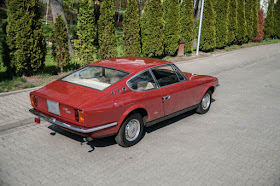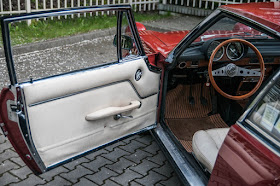The Fiat 125 is a large family car introduced by Fiat in 1967 and produced by them until 1972. The engine was based on the one fitted in the Fiat 124 Sport: a 1608 cc DOHC unit with 90 bhp driving the rear wheels. In 1968 the 125S ("Special") was added to the range, with 100 bhp (from a modified cylinder head, camshafts, inlet/outlet manifold and Weber/Solex carburettor) and, unusually at this time, a five-speed gearbox. It also had one of the world's first intermittent wipers, halogen lights, servo-assisted twin circuit brakes and optional superlight magnesium wheels.
Other versions were built by Moretti, who made the 125GS 1.6 with styling similar to the Fiat Dino Spider. Zagato made the 125Z; Savio, a 125 Coupé and 125 Station Wagon; Bertone, a 125 Executive; and Vignale produced the Samantha, a two-door coupé with pop-up headlights, designed by Virginio Vairo.
The Fiat Samantha's gorgeous looks are owed to the Italian company Carrozzeria Vignale, founded in Turin in 1948. Vignale designed and built bodies for low volume variants of the main production cars of other automobile manufacturers – mostly Italian, such as Alfa Romeo, Cisitalia, Maserati or Fiat. The Samantha's svelte body with pop-up headlamps (reminiscent of Lamborghini Miura) was designed by Virginio Vairo. He was commissioned to do so by the CEO and founder of the company, Mr. Alfredo Vignale himself. Mr. Vignale’s intent was to create a Gran Turismo car: attractive on the outside, but ready to cover long distances and comfortably accommodate four people with their luggage onboard.
The Fiat 125 S was used as a base, with which Samantha Vignale shared its chassis and its 1.6-litre, 100 BHP engine. Combined with a five-speed, manual gearbox, its performance was pretty brisk – acceleration from standstill to 100 km/h took around 13 seconds. Unfortunately, Samantha Vignale was twice as expensive as the 125 S.
Only 100 examples of the Samantha were made. They weren’t sold in official dealerships, but in independent, specialized workshops. Nowadays it’s becoming increasingly sought after and more popular among classic car fans. (wikipedia & classicdriver.com)
(Photos from classicdriver.com, carandclassic.co.uk, mossgreen.com.au, ruotevecchie.org,
powerful-cars.com, flickr.com, bonhams.com, maidstone.pl & en.wheelsage.org)





























































































































